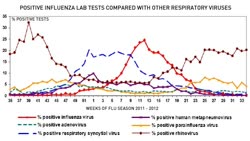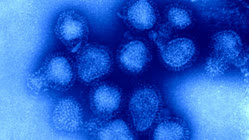|
WHO declares swine flu pandemic, no change in Canada's approach Swine flu, or H1N1 influenza, has reached the pandemic level, the World Health Organization warned Thursday — marking the first time it has called a global flu epidemic in 41 years. |
|
Swine flu roots traced to Spanish flu The CDC in the U.S. said on Friday the new strain is "a very unusual" combination of human genes and genes from swine and avian flu viruses found in North America, Asia and Europe. |
|
B.C. to dump $20M in swine flu vaccine
The B.C. government hopes to recover at least part of the $20-million cost of swine flu vaccine it has to dump because the serum is unexpectedly spoiling far in advance of its best-before date.
|
|
$425.9M pandemic flu contract awarded GlaxoSmithKline gets 10-year contract, |
|
H1N1 pandemic response flawed: report
Swine flu was a mild virus and most people infected didn't need medical treatment to recover. That led some critics to suggest WHO's declaration of a pandemic was the result of collusion with pharmaceutical companies, who made millions selling vaccines worldwide. |
|
Flu deaths reality check Nov 25, 2012 5:14 PM ET
Credibility of flu models disputed  |
|
Flu shot linked to higher incidence of flu in pandemic year Canadian researchers noticed in the early weeks of the pandemic that people who got a flu shot for the 2008-2009 winter seemed to be more likely to get infected with the pandemic virus than people who hadn't received a flu shot.
|
|
H1N1 flu shots likely tied to increase in paralysis syndrome The Canadian Press · Posted: Jul 11, 2012 11:59 AM ET | Last Updated: July 11, 2012
The flu vaccine used during the 2009 pandemic may have led to a slight increase in cases of Guillain-Barré syndrome in Quebec, a new study from the province suggests.
|
|
Health Canada pulls distribution of Novartis flu vaccines Small clumps of virus particles found in some batches, affecting efficacy. |
|
"its severity is in line with the 1968 Hong Kong flu"
The 64-year-old was sick for a week before she was admitted to hospital and diagnosed with H1N1. She died on Wednesday after spending nearly a month in intensive care, said her son Greg Scheelar.
|
|
"expects it will be similar to last year's 60 per cent effectiveness" Health officials in B.C. are advising young people to get a flu vaccine after determining that the H1N1 influenza strain, which circulated during the global pandemic in 2009, has returned to become the predominant strain this flu season.
|
|
"As well, AstraZeneca — the maker of FluMist, a vaccine puffed into a nostril — is providing 157,000 doses" "Perplexingly, last year's flu season was harsher than this year's — or at least from what can be seen to date. But the main strain this year, H1N1, can hit young and middle-aged adults very hard. Reports of people in that demographic being hospitalized, placed in intensive care and occasionally even dying have received heavy media coverage." |
|
More flu-related deaths this year than pandemic in 2009 There are now 16 flu-related deaths in Saskatchewan this flu season, which is more than the 15 people who died during the pandemic in 2009. |
|
Flu vaccine only 23% effective in U.S., even less effective in Canada Jan 15, 2015 1:44 PM ET
The effectiveness was highest among children aged six months to 17 at 26 per cent. Effectiveness fell to about 12 per cent among people aged 18 to 49 and 14 per cent for those aged 50 and older.
|
|
The 2015 shot offered no protection Jan 29, 2015 7:16 PM ET "This year's flu vaccine offers little or no protection in Canada against becoming sick enough to require medical care, a study published Thursday suggests." |
|
CBC/BC CDC - seasonal flu vaccination almost doubled the risk of infection with pandemic flu "The more shots you get the less they work."
People who receive flu vaccines year after year can sometimes show reduced protection, an effect that Canadian infectious disease specialists say muddies public health messages for annual flu vaccine campaigns.
|
|
Flu shot effectiveness for 2015-16 disappointing, data shows July 2016
'It's an improvement over the previous year, because it couldn't be worse, frankly.' - Dr. Danuta Skowronski, BC Centre for Disease Control "Overall, just shy of 45 to 50 per cent," said Dr. Danuta Skowronski of the BC Centre for Disease Control, who presented the data to the Global Influenza Vaccine Effectiveness meeting at the World Health Organization last week. "That's lower than we would like to see, but it's an improvement over the previous year, because it couldn't be worse, frankly" In 2014-15, the flu shot offered essentially zero protection against the circulating influenza virus of that season. Back then, the prevailing strain was H3N2. This year's main circulating virus was H1N1, which flu watchers will remember from the pandemic of 2009-10. Skowronski said the vaccine was well-matched, but overall, the protection was disappointing 'There's no use promoting a vaccine that isn't working well.' - Dr. Danuta Skowronski, BC Centre for Disease Control
|
|
Flu spray fails again, U.S. panel urges shot instead
Nasal spray dismal for third straight year, traditional flu jab worked reasonably well this winter, CDC finds
|
|
This year's flu shot may be ineffective, but you should still get it This flu season is turning into a particularly nasty one as Canada, the U.S. and other parts of the world battle epidemic levels of the illness, overwhelming hospitals. |
|
Puzzling study prompts call to examine flu vaccine and miscarriage A puzzling study of U.S. pregnancies found that women who had miscarriages between 2010 and 2012 were more likely to have had back-to-back annual flu shots that included protection against swine flu. |
|
Last year's flu vaccine wasn't very effective. This year's looks more promising "Health officials believe they have a better vaccine match for this year's expected flu strains" |
|
Worst start to flu season since 2010 Data released by the office of the Chief Medical Officer of Health show that the start of the 2018-19 flu season has been the worst in almost a decade.
|
|
Official government flu statistics |
|
'worst kind' of flu season - evolving strain may be mismatch for vaccine
Alarm bells abroad, spread of a new form of H3N2 provide warnings as influenza cases start ticking up |

